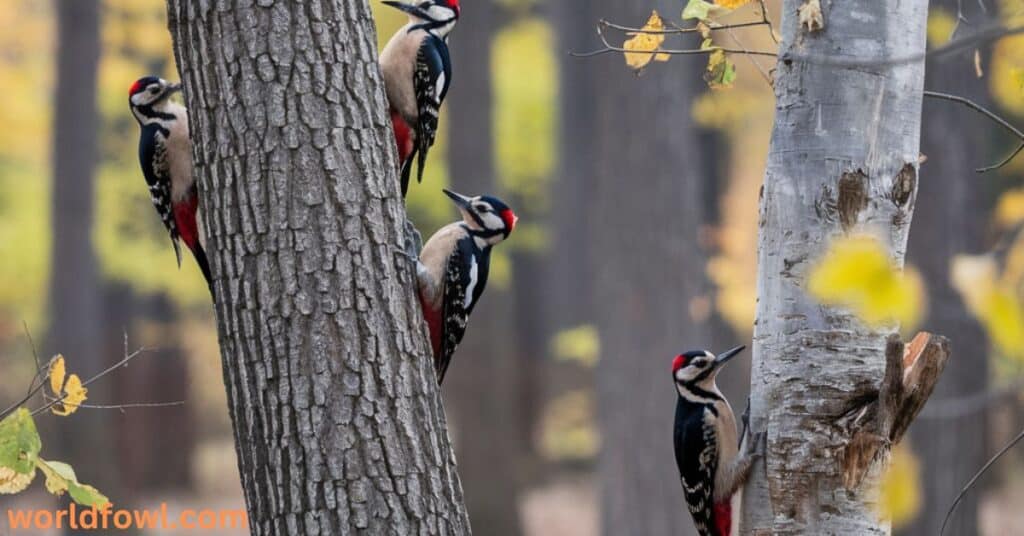Michigan’s diverse landscapes, rich ecosystems, and a mix of urban and natural spaces create an environment perfect for a variety of wildlife, especially woodpeckers. These fascinating birds play vital roles in maintaining the ecological balance of Michigan’s forests, fields, and even urban green spaces. From creating nesting cavities for other animals to controlling insect populations, woodpeckers are essential contributors to the biodiversity of the state. In this article, we’ll take an in-depth look at the eight most sensational Woodpeckers In Michigan, delving into their characteristics, behavior, habitat preferences, and how you can spot them in the wild.
Why Michigan is a Hotspot for Woodpeckers
Michigan’s geographical features, ranging from dense boreal forests to expansive wetlands and suburban yards, create a unique environment where a wide variety of woodpecker species can thrive. These birds are not just found in remote, wild forests but also adapt to urban and suburban environments. This diversity in habitat choices, along with an abundance of food sources such as insects and sap from trees, makes Michigan an ideal place for these birds to flourish.
Woodpeckers are crucial to the ecosystems in which they live. Their behavior, particularly their drumming, foraging, and the creation of nesting cavities, helps maintain the ecological balance. Insect-boring pests are controlled through their feeding habits, and their activities also provide homes for other species of birds and mammals. Therefore, these avian creatures are indispensable in the overall health of Michigan’s forests and urban areas.
In Michigan, whether you’re hiking the dense woods of the Upper Peninsula or observing birds in a local park, woodpeckers are a constant presence. The state’s avian diversity and unique forest structure support woodpeckers across various landscapes. Now, let’s explore eight sensational woodpecker species that you’re likely to encounter while exploring Michigan.
you might like : Do Woodpeckers Migrate? What Are The Costs and Benefits ?
Black-backed Woodpecker – The Ghost of Michigan’s Boreal Forests

The Black-backed Woodpecker is one of the rarest woodpecker species in Michigan, primarily inhabiting the boreal forests of the Upper Peninsula. This woodpecker’s preference for dead and burned trees makes it one of the most specialized species in the state. The Black-backed Woodpecker is not a common sight, and its elusive nature adds to its mystique.
Key Features:
- Appearance: The Black-backed Woodpecker has a striking black back, a white underside, and a small white spot on the wings. Its overall appearance is sleek and minimalist, blending in with its burnt forest habitat.
- Size: It measures between 9 to 10 inches in length, a medium-sized woodpecker.
- Behavior: Black-backed Woodpeckers are known for their unique feeding habits. They prefer burned forests or areas damaged by fire, where they forage for wood-boring beetles, larvae, and other insects that infest the decaying wood. Their behavior is highly specialized, making them ecologically important for forest recovery after fires.
Habitat and Feeding
These woodpeckers are generally found in the northernmost parts of Michigan, in remote forests that have experienced fire damage or other disturbances. Unlike many other woodpeckers that prefer healthy live trees, the Black-backed Woodpecker thrives in environments where dead trees provide abundant food sources. This feeding behavior helps restore forest ecosystems by controlling the insect populations that can devastate a forest.
Due to their habitat preferences, spotting a Black-backed Woodpecker can be difficult. Birdwatchers must travel to the more remote regions of Michigan, such as the Pictured Rocks National Lakeshore or the forests surrounding the Porcupine Mountains, where these woodpeckers are more likely to be found.
Downy Woodpecker – Michigan’s Most Common Woodpecker
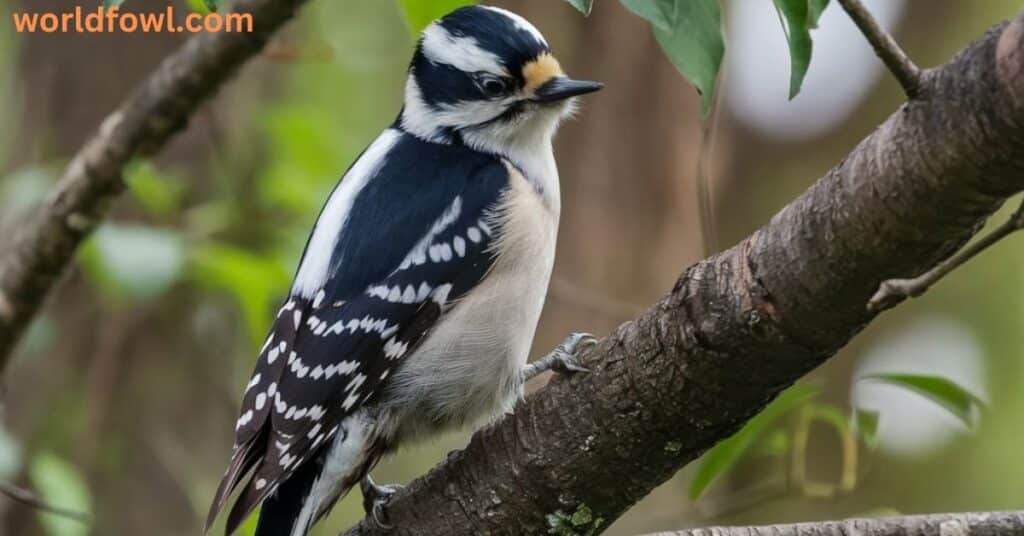
The Downy Woodpecker is the smallest and most common woodpecker species in Michigan, and it’s easily recognized by its small size and distinctive appearance. It is one of the few woodpeckers that thrive in suburban and urban environments, making it an ideal species for birdwatchers across the state.
Key Features:
- Appearance: Small in size, the Downy Woodpecker has a white belly and back, black-and-white striped wings, and a small red patch on the back of the head (only on males). Its size and markings make it easily distinguishable from other woodpeckers.
- Size: Around 6 to 7 inches in length, this is one of the smallest woodpeckers.
- Behavior: Downy Woodpeckers are frequently seen foraging on tree trunks and branches, searching for insects like ants, beetles, and other insect larvae. They are known for their drumming sound, which is used to communicate with other woodpeckers and to mark territory.
Habitat and Feeding
The Downy Woodpecker is incredibly adaptable, found in forests, suburban yards, parks, and orchards. It thrives in environments where there is a mixture of deciduous trees and open spaces. This species is most commonly seen in areas with mature trees, as these trees provide both food and potential nesting cavities.
How to Spot Them
Downy Woodpeckers are common in urban and suburban areas, making them accessible for many birdwatchers. They are easy to identify by their small size and rapid foraging behaviors. Look for them tapping on tree trunks in search of insects, particularly during the spring and summer months, when they are most active.
you might like : Woodpeckers In Indiana – 7 Indiana Woodpeckers (With Photos)
Hairy Woodpecker – The Larger Cousin of the Downy
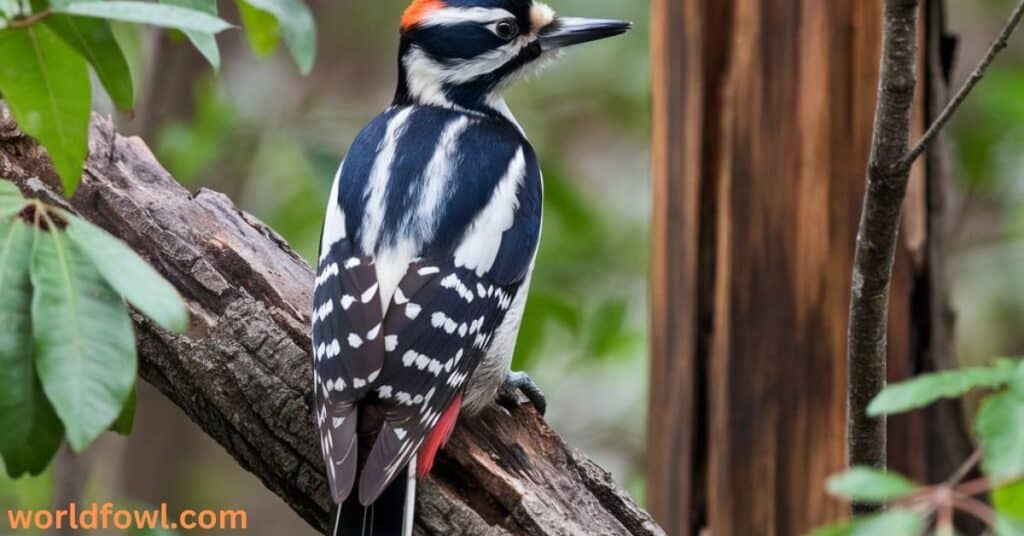
The Hairy Woodpecker is often mistaken for the Downy Woodpecker, but it is a larger and more robust species. It shares many characteristics with the Downy, but a few distinguishing features make it stand out in Michigan’s forests.
Key Features:
- Appearance: The Hairy Woodpecker has a similar black-and-white pattern as the Downy, but it has a larger bill and a white spot on its back. It’s slightly larger and more powerful in its drumming and foraging.
- Size: Around 9 to 10 inches in length, significantly larger than the Downy.
- Behavior: Hairy Woodpeckers have a similar feeding style to the Downy, but they often forage on larger trees. They also use their powerful beaks to drum louder, and their drumming can be heard from a distance. This drumming is not just for communication but also for territorial marking.
Habitat and Feeding
Hairy Woodpeckers are found in mature forests and wooded suburban areas. They prefer areas with large trees, especially where insect infestations provide an abundance of food. They feed on a variety of insects, including ants and beetles, and often strip the bark off trees in search of insect larvae.
How to Spot Them
Hairy Woodpeckers are common in forested areas throughout Michigan, particularly in areas with mature trees. Their larger size and louder drumming make them easier to spot compared to the Downy Woodpecker. Look for them in woodlands, especially near the trunks of large trees, during the spring and summer.
Northern Flicker – The Ground-Loving Woodpecker
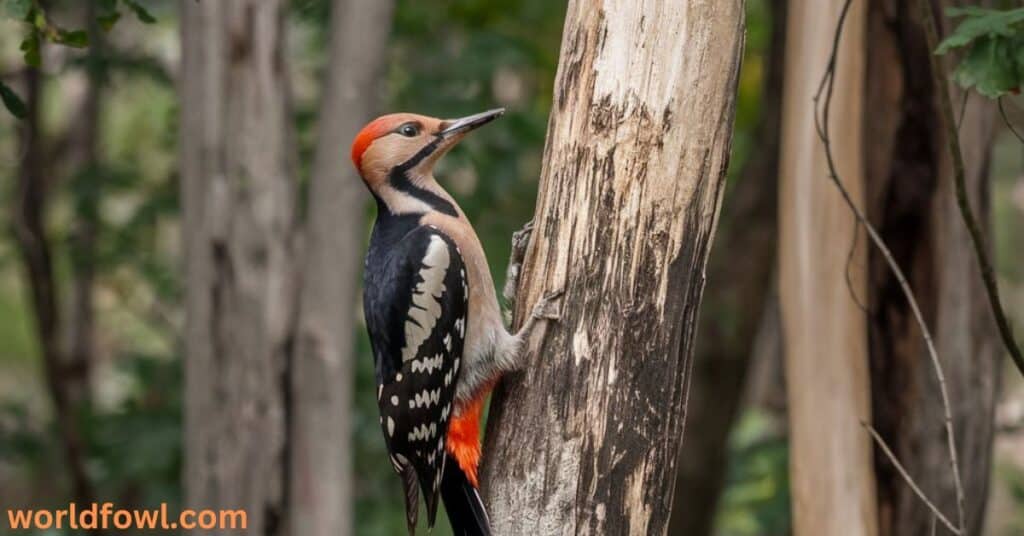
The Northern Flicker stands out from other woodpeckers due to its unique ground-feeding habits. Unlike most woodpeckers, which prefer foraging on tree trunks, Northern Flickers are often seen on the ground, where they hunt for insects and other food sources.
Key Features:
- Appearance: The Northern Flicker is a larger woodpecker, with brownish feathers speckled with black spots. It has a distinctive crescent-shaped marking on its back and a prominent yellow or red tail (depending on the region).
- Size: Larger than many other woodpeckers, measuring about 12 to 14 inches in length.
- Behavior: The Northern Flicker is unique in that it forages on the ground for ants and beetles, particularly ant colonies, which make up a significant portion of its diet. This behavior is a distinguishing feature, as most woodpeckers forage on trees.
Habitat and Feeding
Northern Flickers are widespread throughout Michigan and can be found in open woodlands, fields, and even suburban yards. They prefer environments where they can easily forage for ants and beetles, making suburban lawns and grasslands perfect habitats. Their feeding behavior plays an important role in controlling insect populations.
How to Spot Them
If you are birdwatching in a suburban yard or field, keep an eye out for Northern Flickers on the ground, especially during the spring and summer months. They are also frequently seen drumming on tree trunks to communicate with other birds and mark their territory.
you may like : Do Woodpeckers Kill Trees? The Good and Bad Of Woodpeckers
Pileated Woodpecker – Michigan’s Giant Woodpecker
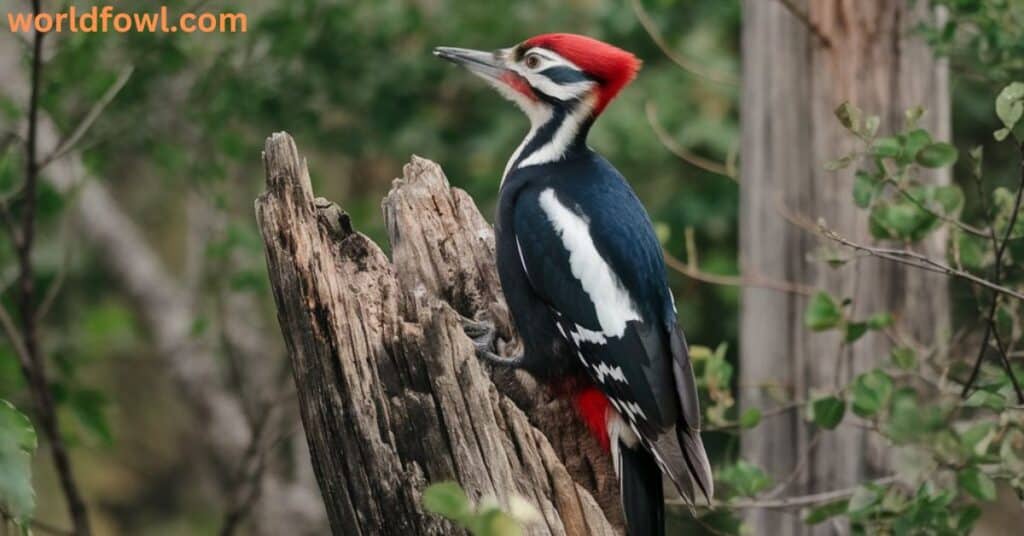
The Pileated Woodpecker is one of Michigan’s most impressive woodpecker species, known for its dramatic appearance and larger size. It’s often considered a symbol of forest health, as it plays an important role in the structure of mature forests.
Key Features:
- Appearance: The Pileated Woodpecker is one of the largest woodpeckers in North America, with striking black plumage, a white belly, and a prominent red crest on its head.
- Size: It measures around 16 to 19 inches in length, making it one of the largest woodpecker species in Michigan.
- Behavior: Known for its powerful drumming and its distinctive call, the Pileated Woodpecker can be heard from a distance. It is also a primary cavity excavator, which means it creates nesting cavities used by a variety of other birds and mammals.
Habitat and Feeding
Pileated Woodpeckers prefer mature forests with large, dead trees. These woodpeckers are often seen drilling into trees in search of ants, termites, and beetle larvae. Their large, powerful bills are perfect for digging into decaying wood and accessing these food sources.
How to Spot Them
Pileated Woodpeckers are often found in Michigan’s forested areas, particularly those that are old and have many decaying trees. They are loud, and their large size makes them hard to miss. Look for them high in the trees or listen for their characteristic drumming.
Red-bellied Woodpecker – A Colorful Resident of Michigan
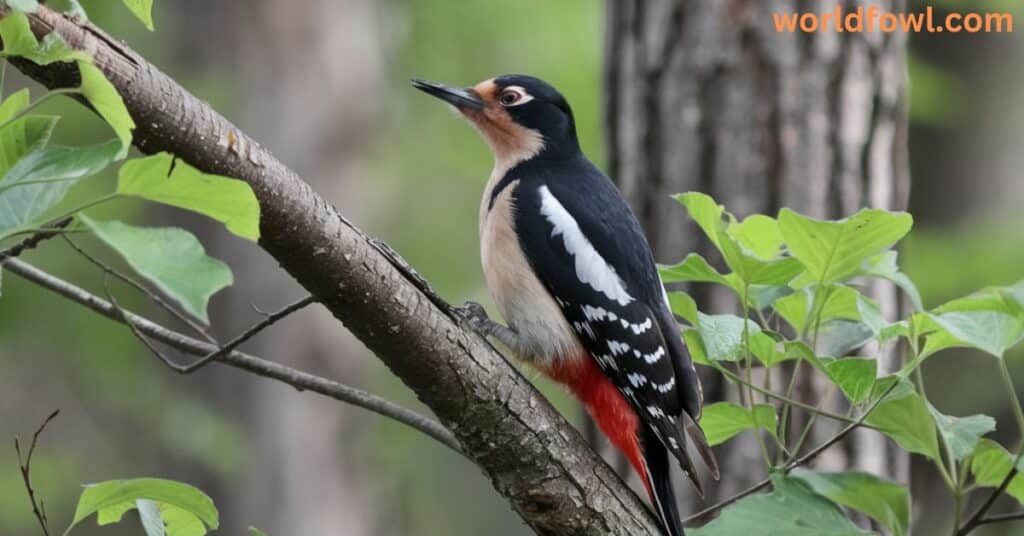
The Red-bellied Woodpecker is a colorful species that is often spotted in Michigan’s urban parks and forests. Its distinctive markings and active foraging behavior make it a popular species among birdwatchers.
Key Features:
- Appearance: The Red-bellied Woodpecker has a striking red patch on its head and a pale belly. While the belly is not entirely red, the slight red hue is noticeable and gives the bird its name.
- Size: About 9 to 10 inches in length, making it slightly smaller than the Pileated Woodpecker but still a medium-sized bird.
- Behavior: Red-bellied Woodpeckers are frequent visitors to urban green spaces and can be seen drumming on tree trunks in search of insects. Their primary food sources include ants, beetles, and other insect larvae.
Habitat and Feeding
Red-bellied Woodpeckers are adaptable and can be found in a variety of habitats, from forests to urban parks. They prefer deciduous trees, where they can find insects, but they are also frequent visitors to bird feeders in suburban and urban green spaces.
How to Spot Them
Look for Red-bellied Woodpeckers in parks, backyards, and wooded areas throughout Michigan. They are active throughout the year, and their colorful plumage makes them easy to spot in the tree canopy.
you might like : Are There Blue Cardinals?
Red-headed Woodpecker – The Rare Jewel of Michigan
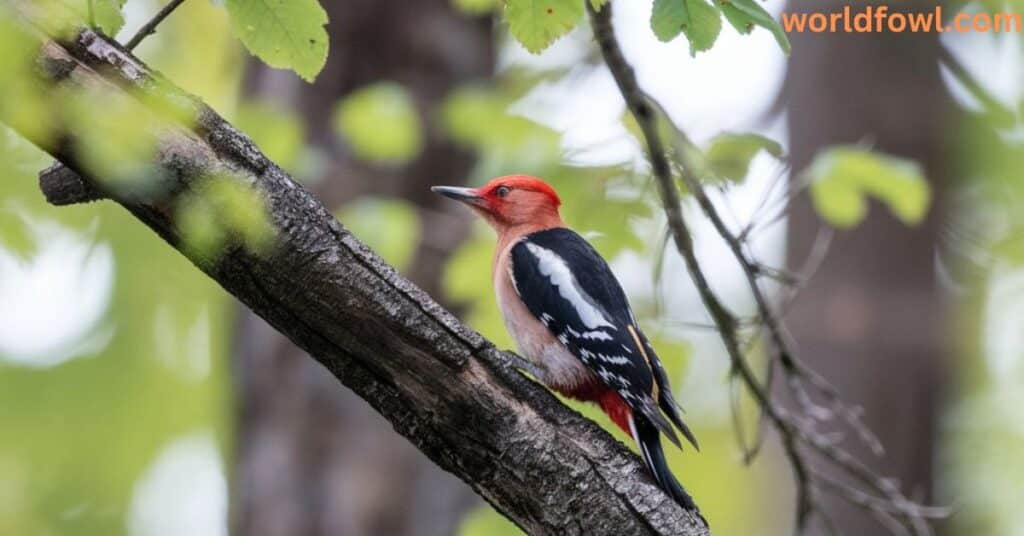
The Red-headed Woodpecker is one of the most striking and rare woodpeckers in Michigan. Its bright red head and contrasting black-and-white body make it stand out in any habitat.
Key Features:
- Appearance: The Red-headed Woodpecker is known for its vibrant red head, white belly, and black back. It’s a striking bird, and its appearance makes it easy to identify.
- Size: About 9 to 10 inches long.
- Behavior: The Red-headed Woodpecker is highly territorial and is often seen drumming on trees to establish dominance. It feeds on insects as well as fruits and nuts.
Habitat and Feeding
Red-headed Woodpeckers prefer open woodlands, farmlands, and urban parks, where they can easily forage for insects and nuts. They are also known for storing food in tree crevices, making them unique among woodpeckers.
How to Spot Them
The Red-headed Woodpecker is a rare sight in Michigan, but it can be found in open woodlands and parks. Keep an eye out for their brilliant red heads and distinctive drumming.
Yellow-bellied Sapsucker – The Expert Sap Feeder
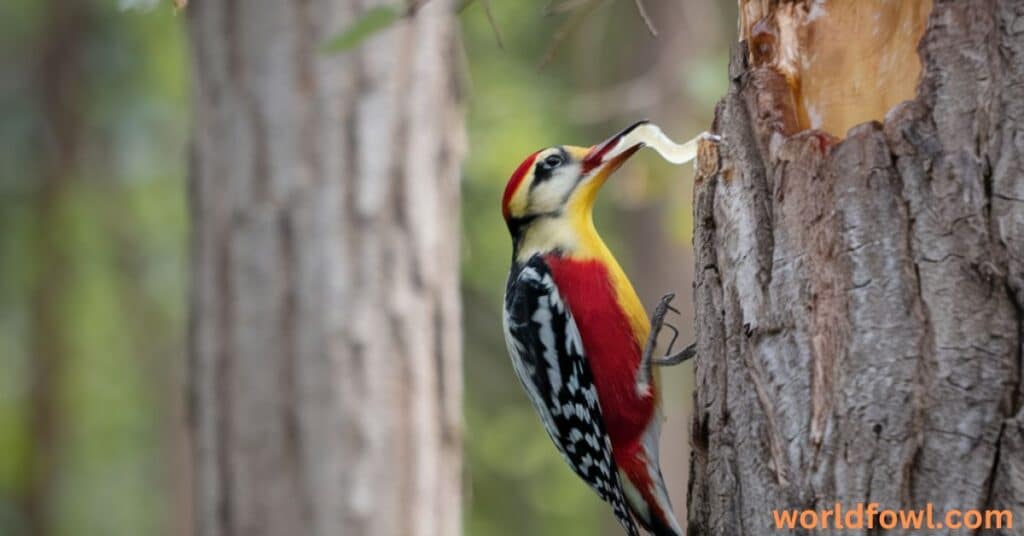
The Yellow-bellied Sapsucker is a woodpecker species known for its unique ability to feed on tree sap. It creates distinctive sap wells in trees, which it visits regularly.
Key Features:
- Appearance: The Yellow-bellied Sapsucker has a red crown and throat, with a white belly and black-and-white stripes along its wings and back.
- Size: Measures about 8 to 9 inches long.
- Behavior: The Yellow-bellied Sapsucker is a unique forager that taps into trees to extract sap, often creating a pattern of holes known as “sap wells.” It feeds on the sap and also catches insects attracted to the sugary liquid.
Habitat and Feeding
This woodpecker is often found in forests and wetlands. Its preference for trees with high sap content, such as birches and maples, makes it a common sight in Michigan’s forests during the spring and early summer.
How to Spot Them
Look for Yellow-bellied Sapsuckers in areas where maple trees or other sap-bearing trees grow. Their drumming sound is typically the first clue of their presence.
Conclusion: Why Michigan’s Woodpecker Species Matter
Michigan’s woodpecker species are a testament to the state’s rich biodiversity and ecological balance. These birds contribute in various ways to forest health, insect control, and habitat creation. As a birdwatcher, spotting these woodpeckers is a rewarding experience that connects you to the natural world. Whether you’re in a suburban yard, hiking through Michigan’s forests, or exploring the wetlands, these woodpeckers are everywhere. Remember to keep an eye out for their drumming, distinctive plumage, and feeding behavior – and celebrate the role they play in Michigan’s avian diversity.
FAQs about Woodpeckers in Michigan
What is the best time of year to spot woodpeckers in Michigan?
The best time to observe woodpeckers in Michigan is during the spring and summer months when they are most active. Woodpeckers are busy foraging, establishing territories, and drumming to communicate and attract mates. This is when their activities are most noticeable. However, woodpeckers can also spotted throughout the year, especially during the winter months, when their feeding habits and nesting cavities play a crucial role in the forest ecosystem.
How can I attract woodpeckers to my yard in Michigan?
Attracting woodpeckers to your yard involves providing food sources, such as suet, peanut butter, and sunflower seeds, which often favored by many species. Planting trees with a good amount of insect populations or sap-producing trees like maples and birches will also make your yard more inviting to woodpeckers. Additionally, creating or preserving dead trees or stumps in your yard will provide potential nesting cavities and foraging spots for these birds.
Are woodpeckers in Michigan endangered?
While some woodpecker species in Michigan, such as the Black-backed Woodpecker considered rare and face potential threats due to habitat loss, most woodpeckers in the state are not classified as endangered. Conservation efforts have helped to stabilize many populations. However, it’s important to continue supporting bird conservation and habitat preservation to ensure these fascinating birds thrive, particularly in areas where forest disturbances like fire or logging occur.
How do woodpeckers communicate with each other?
Woodpeckers communicate primarily through drumming and vocalizations. Drumming serves multiple purposes: it marks territory, attracts mates, and signals presence. Each species has its own rhythm and frequency of drumming. Vocalizations, such as calls and chattering, are also important in communication, especially during the mating season or when signaling danger.

Henry James is a seasoned blogger and a passionate storyteller on “World Fowl.” With years of experience crafting engaging content, he brings a unique blend of expertise and creativity to his writing. Henry specializes in exploring diverse topics with depth and clarity, captivating readers worldwide.

